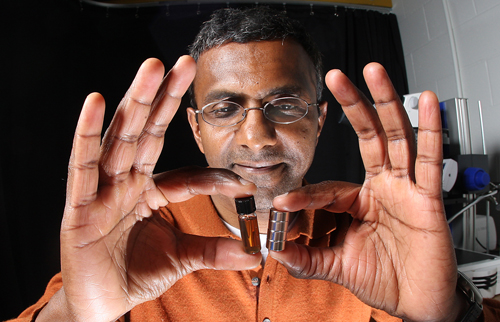Home > Press > Nanoscopic probes can track down and attack cancer cells
 |
| Purdue professor Joseph Irudayaraj uses a magnet to attract tiny magnetic particles in a solution. Irudayaraj designed nanoprobes with gold and magnetic particles that could be used to deliver drugs directly to cancer cells. (Purdue Agricultural Communication photo/Tom Campbell) |
Abstract:
A researcher has developed probes that can help pinpoint the location of tumors and might one day be able to directly attack cancer cells.
Nanoscopic probes can track down and attack cancer cells
West Lafayette, IN | Posted on March 16th, 2009Joseph Irudayaraj, a Purdue University associate professor of agricultural and biological engineering, developed the nanoscale, multifunctional probes, which have antibodies on board, to search out and attach to cancer cells.
A paper detailing the technology was released last week in the online version of Angewandte Chemie, an international chemistry journal.
"If we have a tumor, these probes should have the ability to latch on to it," Irudayaraj said. "The probe could carry drugs to target, treat as well as reveal cancer cells."
Scientists have developed probes that use gold nanorods or magnetic particles, but Irudayaraj's nanoprobes use both, making them easier to track with different imaging devices as they move toward cancer cells.
The magnetic particles can be traced through the use of an MRI machine, while the gold nanorods are luminescent and can be traced through microscopy, a more sensitive and precise process. Irudayaraj said an MRI is less precise than optical luminescence in tracking the probes, but has the advantage of being able to track them deeper in tissue, expanding the probes' possible applications.
The probes, which are about 1,000 times smaller than the diameter of a human hair, contain the antibody Herceptin, used in treatment of metastatic breast cancer. The probes would be injected into the body through a saline buffering fluid, and the Herceptin would find and attach to protein markers on the surface of cancer cells.
"When the cancer cell expresses a protein marker that is complementary to Herceptin, then it binds to that marker," Irudayaraj said. "We are advancing the technology to add other drugs that can be delivered by the probes."
Irudayaraj said better tracking of the nanoprobes could allow doctors to pinpoint the location of known tumors and better treat the cancer.
The novel probes were tested in cultured cancer cells. Irudayaraj said the next step would be to run a series of tests in mice models to determine the dose and stability of the probes.
The research was funded through a National Institute of Health grant, as well as by the Purdue Research Foundation. Irudayaraj is head of a biological engineering team that includes postdoctoral researcher Chungang Wang and graduate student Jiji Chen.
####
Contacts:
Writer: Brian Wallheimer, (765) 496-2050,
Source: Joseph Irudayaraj, (765) 494-0388,
Ag Communications: (765) 494-2722;
Beth Forbes,
Agriculture News Page
Copyright © Purdue University
If you have a comment, please Contact us.Issuers of news releases, not 7th Wave, Inc. or Nanotechnology Now, are solely responsible for the accuracy of the content.
| Related Links |
![]() Purdue University Agricultural News
Purdue University Agricultural News
| Related News Press |
News and information
![]() Simulating magnetization in a Heisenberg quantum spin chain April 5th, 2024
Simulating magnetization in a Heisenberg quantum spin chain April 5th, 2024
![]() NRL charters Navy’s quantum inertial navigation path to reduce drift April 5th, 2024
NRL charters Navy’s quantum inertial navigation path to reduce drift April 5th, 2024
![]() Discovery points path to flash-like memory for storing qubits: Rice find could hasten development of nonvolatile quantum memory April 5th, 2024
Discovery points path to flash-like memory for storing qubits: Rice find could hasten development of nonvolatile quantum memory April 5th, 2024
Possible Futures
![]() Discovery points path to flash-like memory for storing qubits: Rice find could hasten development of nonvolatile quantum memory April 5th, 2024
Discovery points path to flash-like memory for storing qubits: Rice find could hasten development of nonvolatile quantum memory April 5th, 2024
![]() With VECSELs towards the quantum internet Fraunhofer: IAF achieves record output power with VECSEL for quantum frequency converters April 5th, 2024
With VECSELs towards the quantum internet Fraunhofer: IAF achieves record output power with VECSEL for quantum frequency converters April 5th, 2024
Nanomedicine
![]() New micromaterial releases nanoparticles that selectively destroy cancer cells April 5th, 2024
New micromaterial releases nanoparticles that selectively destroy cancer cells April 5th, 2024
![]() Good as gold - improving infectious disease testing with gold nanoparticles April 5th, 2024
Good as gold - improving infectious disease testing with gold nanoparticles April 5th, 2024
![]() Researchers develop artificial building blocks of life March 8th, 2024
Researchers develop artificial building blocks of life March 8th, 2024
Sensors
Announcements
![]() NRL charters Navy’s quantum inertial navigation path to reduce drift April 5th, 2024
NRL charters Navy’s quantum inertial navigation path to reduce drift April 5th, 2024
![]() Discovery points path to flash-like memory for storing qubits: Rice find could hasten development of nonvolatile quantum memory April 5th, 2024
Discovery points path to flash-like memory for storing qubits: Rice find could hasten development of nonvolatile quantum memory April 5th, 2024
Nanobiotechnology
![]() New micromaterial releases nanoparticles that selectively destroy cancer cells April 5th, 2024
New micromaterial releases nanoparticles that selectively destroy cancer cells April 5th, 2024
![]() Good as gold - improving infectious disease testing with gold nanoparticles April 5th, 2024
Good as gold - improving infectious disease testing with gold nanoparticles April 5th, 2024
![]() Researchers develop artificial building blocks of life March 8th, 2024
Researchers develop artificial building blocks of life March 8th, 2024
|
|
||
|
|
||
| The latest news from around the world, FREE | ||
|
|
||
|
|
||
| Premium Products | ||
|
|
||
|
Only the news you want to read!
Learn More |
||
|
|
||
|
Full-service, expert consulting
Learn More |
||
|
|
||








